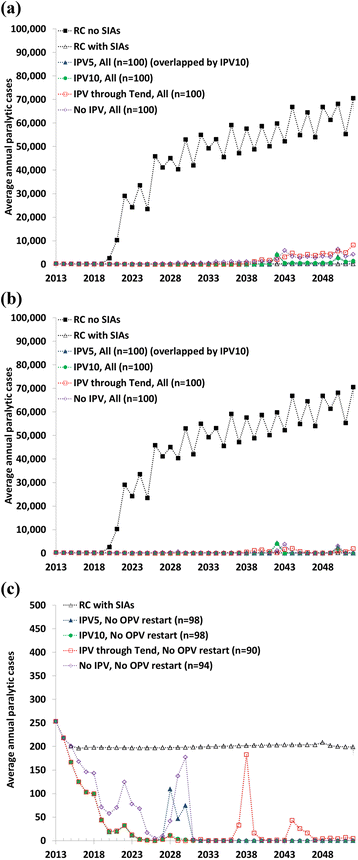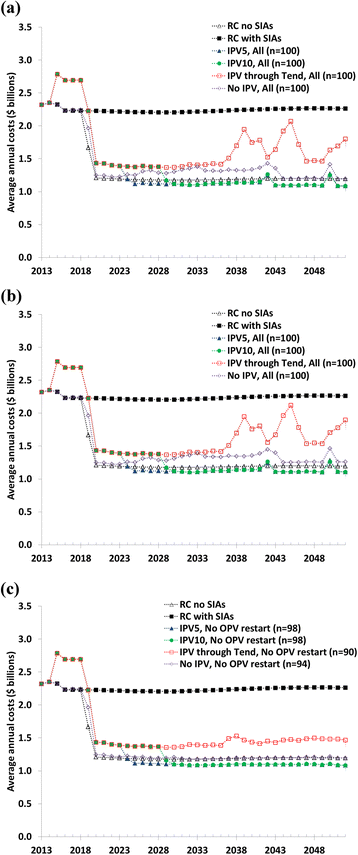An economic analysis of poliovirus risk management policy options for 2013-2052
- PMID: 26404632
- PMCID: PMC4582932
- DOI: 10.1186/s12879-015-1112-8
An economic analysis of poliovirus risk management policy options for 2013-2052
Abstract
Background: The Global Polio Eradication Initiative plans for coordinated cessation of oral poliovirus vaccine (OPV) after interrupting all wild poliovirus (WPV) transmission, but many questions remain related to long-term poliovirus risk management policies.
Methods: We used an integrated dynamic poliovirus transmission and stochastic risk model to simulate possible futures and estimate the health and economic outcomes of maintaining the 2013 status quo of continued OPV use in most developing countries compared with OPV cessation policies with various assumptions about global inactivated poliovirus vaccine (IPV) adoption.
Results: Continued OPV use after global WPV eradication leads to continued high costs and/or high cases. Global OPV cessation comes with a high probability of at least one outbreak, which aggressive outbreak response can successfully control in most instances. A low but non-zero probability exists of uncontrolled outbreaks following a poliovirus reintroduction long after OPV cessation in a population in which IPV-alone cannot prevent poliovirus transmission. We estimate global incremental net benefits during 2013-2052 of approximately $16 billion (US$2013) for OPV cessation with at least one IPV routine immunization dose in all countries until 2024 compared to continued OPV use, although significant uncertainty remains associated with the frequency of exportations between populations and the implementation of long term risk management policies.
Conclusions: Global OPV cessation offers the possibility of large future health and economic benefits compared to continued OPV use. Long-term poliovirus risk management interventions matter (e.g., IPV use duration, outbreak response, containment, continued surveillance, stockpile size and contents, vaccine production site requirements, potential antiviral drugs, and potential safer vaccines) and require careful consideration. Risk management activities can help to ensure a low risk of uncontrolled outbreaks and preserve or further increase the positive net benefits of OPV cessation. Important uncertainties will require more research, including characterizing immunodeficient long-term poliovirus excretor risks, containment risks, and the kinetics of outbreaks and response in an unprecedented world without widespread live poliovirus exposure.
Figures


Similar articles
-
Trade-offs of different poliovirus vaccine options for outbreak response in the United States and other countries that only use inactivated poliovirus vaccine (IPV) in routine immunization.Vaccine. 2024 Feb 6;42(4):819-827. doi: 10.1016/j.vaccine.2023.12.081. Epub 2024 Jan 12. Vaccine. 2024. PMID: 38218668 Free PMC article. Review.
-
Health and economic consequences of different options for timing the coordinated global cessation of the three oral poliovirus vaccine serotypes.BMC Infect Dis. 2015 Sep 17;15:374. doi: 10.1186/s12879-015-1113-7. BMC Infect Dis. 2015. PMID: 26381878 Free PMC article.
-
Cost analysis of post-polio certification immunization policies.Bull World Health Organ. 2004 Jan;82(1):9-15. Epub 2004 Feb 26. Bull World Health Organ. 2004. PMID: 15106295 Free PMC article.
-
Characterization of outbreak response strategies and potential vaccine stockpile needs for the polio endgame.BMC Infect Dis. 2016 Mar 24;16:137. doi: 10.1186/s12879-016-1465-7. BMC Infect Dis. 2016. PMID: 27009272 Free PMC article.
-
Updated Characterization of Post-OPV Cessation Risks: Lessons from 2019 Serotype 2 Outbreaks and Implications for the Probability of OPV Restart.Risk Anal. 2021 Feb;41(2):320-328. doi: 10.1111/risa.13555. Epub 2020 Jul 6. Risk Anal. 2021. PMID: 32632925 Free PMC article. Review.
Cited by
-
Increasing Population Immunity Prior to Globally-Coordinated Cessation of Bivalent Oral Poliovirus Vaccine (bOPV).Pathogens. 2024 Sep 17;13(9):804. doi: 10.3390/pathogens13090804. Pathogens. 2024. PMID: 39338995 Free PMC article.
-
Review of Poliovirus Transmission and Economic Modeling to Support Global Polio Eradication: 2020-2024.Pathogens. 2024 May 22;13(6):435. doi: 10.3390/pathogens13060435. Pathogens. 2024. PMID: 38921733 Free PMC article. Review.
-
Trade-offs of different poliovirus vaccine options for outbreak response in the United States and other countries that only use inactivated poliovirus vaccine (IPV) in routine immunization.Vaccine. 2024 Feb 6;42(4):819-827. doi: 10.1016/j.vaccine.2023.12.081. Epub 2024 Jan 12. Vaccine. 2024. PMID: 38218668 Free PMC article. Review.
-
Health Economic Analysis of Antiviral Drugs in the Global Polio Eradication Endgame.Med Decis Making. 2023 Oct-Nov;43(7-8):850-862. doi: 10.1177/0272989X231191127. Epub 2023 Aug 14. Med Decis Making. 2023. PMID: 37577803 Free PMC article.
-
Complexity of options related to restarting oral poliovirus vaccine (OPV) in national immunization programs after OPV cessation.Gates Open Res. 2023 Apr 17;7:55. doi: 10.12688/gatesopenres.14511.1. eCollection 2023. Gates Open Res. 2023. PMID: 37547300 Free PMC article.
References
-
- World Health Organization; Global Polio Eradication Initiative -- List of wild poliovirus by country. http://www.polioeradication.org/Dataandmonitoring/Poliothisweek/Wildpoli.... Accessed January 18 2015.
-
- World Health Organization Transmission of wild poliovirus type 2 - Apparent global interruption. Wkly Epidemiol Rec. 2001;76:95–97. - PubMed
Publication types
MeSH terms
Substances
Grants and funding
LinkOut - more resources
Full Text Sources
Other Literature Sources
Medical

